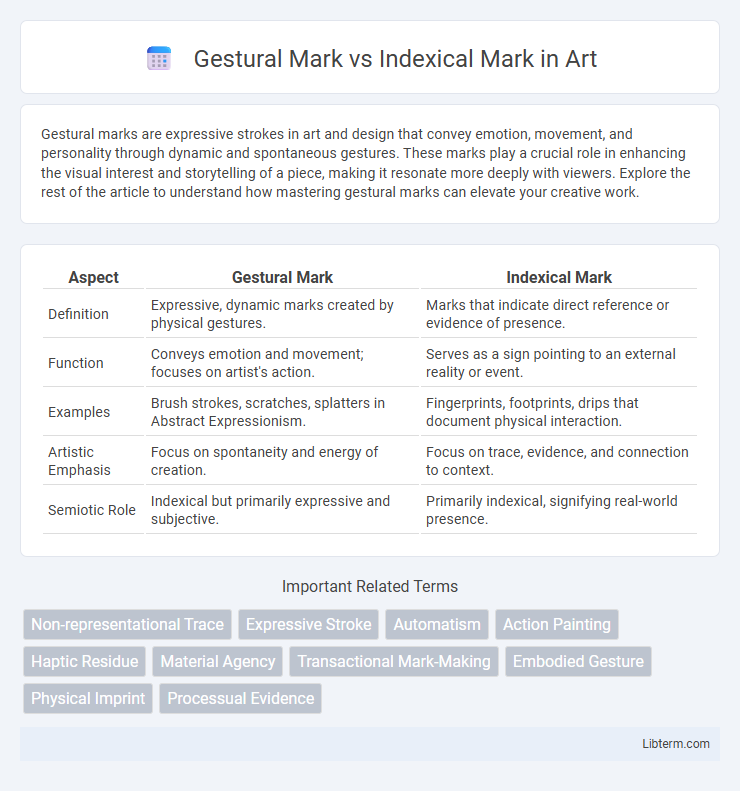Gestural marks are expressive strokes in art and design that convey emotion, movement, and personality through dynamic and spontaneous gestures. These marks play a crucial role in enhancing the visual interest and storytelling of a piece, making it resonate more deeply with viewers. Explore the rest of the article to understand how mastering gestural marks can elevate your creative work.
Table of Comparison
| Aspect | Gestural Mark | Indexical Mark |
|---|---|---|
| Definition | Expressive, dynamic marks created by physical gestures. | Marks that indicate direct reference or evidence of presence. |
| Function | Conveys emotion and movement; focuses on artist's action. | Serves as a sign pointing to an external reality or event. |
| Examples | Brush strokes, scratches, splatters in Abstract Expressionism. | Fingerprints, footprints, drips that document physical interaction. |
| Artistic Emphasis | Focus on spontaneity and energy of creation. | Focus on trace, evidence, and connection to context. |
| Semiotic Role | Indexical but primarily expressive and subjective. | Primarily indexical, signifying real-world presence. |
Defining Gestural Marks: An Overview
Gestural marks are dynamic visual elements created through movement, capturing expressive motions that convey meaning beyond static symbols. Unlike indexical marks, which directly point to or indicate specific referents through a causal or physical connection, gestural marks emphasize the flow and energy of the marking process itself. These marks often appear in art and design as spontaneous, fluid traces reflecting the artist's hand or tool, highlighting a direct, physical interaction with the medium.
Understanding Indexical Marks in Art
Indexical marks in art function as direct indicators or traces of an event, action, or presence, providing a tangible connection between the artist and the creation process. Unlike gestural marks, which emphasize expressive, dynamic movements, indexical marks serve as evidence of physical interaction, such as fingerprints, brush strokes, or tool imprints that anchor the artwork in reality. Understanding indexical marks enhances the appreciation of art as it reveals the material and temporal context behind an image, offering insight into the artist's immediate involvement.
Historical Evolution of Gestural and Indexical Marks
Gestural marks originated in prehistoric cave paintings as early humans used handprints and finger strokes to convey symbolic meanings, reflecting individual presence and social identity. Indexical marks evolved alongside writing systems, functioning as signs that point to specific concepts or referents, such as footprints, directional arrows, and later, written scripts in Mesopotamian cuneiform and Egyptian hieroglyphs. The historical evolution of these marks highlights a shift from primal, embodied expressions to structured, referential symbols enabling complex communication and record-keeping.
Key Differences Between Gestural and Indexical Marks
Gestural marks represent movements or actions made by a person, conveying meaning through physical gestures often tied to cultural or social contexts. Indexical marks, in contrast, function as direct indicators or pointers to a specific object, event, or state, such as footprints indicating presence or smoke signaling fire. The key difference lies in gestural marks expressing intentional human behavior, while indexical marks serve as natural signs linked causally to what they signify.
The Role of the Artist’s Body: Gesture vs. Index
The artist's body functions as a vital medium in gestural marks, where dynamic movement transfers emotion and energy directly onto the canvas, emphasizing physicality and spontaneity. In contrast, indexical marks embody the body's presence through trace evidence, serving as tangible imprints or symbolic references that connect viewer and creator via recorded motion or action. Gestural marks prioritize expressive, fluid motion, while indexical marks highlight residual bodily engagement, anchoring artistic intention in physical indices.
Material Presence: Physicality in Gestural and Indexical Mark-Making
Gestural marks emphasize material presence through dynamic physicality, where the artist's movements and direct contact with the medium create expressive, tactile traces. Indexical marks serve as evidence of an event or action, anchoring material presence by physically imprinting the interaction between tool and surface. Both forms underscore the tangible connection between body and medium, but gestural marks highlight expressive motion while indexical marks prioritize evidential trace.
Expressive Intent: Emotional Resonance of Gestural Marks
Gestural marks convey expressive intent through dynamic brushstrokes and spontaneous movements that evoke deep emotional resonance, contrasting with indexical marks which primarily serve as direct signs or indicators. The fluidity and intensity of gestural marks reflect the artist's subjective feelings and energy, creating a visceral connection with the viewer. This emotional expressiveness distinguishes gestural marks as powerful tools in abstract and expressionist art, emphasizing personal identity and mood.
Trace and Evidence: The Significance of Indexical Marks
Indexical marks function as direct evidence or traces that establish a real-world connection, differentiating them from purely gestural marks which rely on symbolic representation. These indexical signs point to specific causes or origins, such as fingerprints or footprints, providing undeniable proof of presence or action. Their significance lies in grounding communication and interpretation in tangible reality, making them crucial for forensic, linguistic, and semiotic analyses.
Contemporary Practices: Artists Using Gestural and Indexical Techniques
Contemporary artists employ gestural marks to convey emotion and spontaneity through dynamic brushstrokes and physical movement, exemplified by Jackson Pollock's action painting. Indexical marks serve as direct imprints or traces of an artist's interaction with materials, as seen in the fingerprints and tool marks used by Ana Mendieta to connect body and earth. These techniques both emphasize the presence and process of creation, enriching the narrative and tactile dimension of modern art practices.
Interpreting Meaning: Viewer Engagement with Marks in Art
Gestural marks in art convey emotional intensity through dynamic, expressive strokes that invite viewers to interpret the artist's physical movement and personal expression, fostering an immediate, visceral connection. Indexical marks function as direct traces or signs indicating a specific action or presence, guiding viewers to understand the artwork's context or narrative by recognizing tangible evidence of creation. Together, these marks engage viewers differently; gestural marks evoke subjective emotional responses, while indexical marks provide objective clues, deepening interpretive engagement with the artwork's meaning.
Gestural Mark Infographic

 libterm.com
libterm.com